
Allocasuarina huegeliana, commonly known as rock sheoak is a species of flowering plant in the family Casuarinaceae and is endemic to Western Australia. It is a dioecious tree that has its leaves reduced to scales in whorls of eight to ten, the mature fruiting cones 14–35 mm (0.55–1.38 in) long containing winged seeds (samaras) 5–7 mm (0.20–0.28 in) long.

Allocasuarina lehmanniana, commonly known as dune sheoak, is a species of flowering plant in the family Casuarinaceae and is endemic to near-coastal areas of the south-west of Western Australia. It is dioecious or less commonly a monoecious shrub that has its leaves reduced to scales in whorls of six to eight, the mature fruiting cones 12–35 mm (0.47–1.38 in) long containing winged seeds (samaras) 4.0–5.5 mm (0.16–0.22 in) long.

Allocasuarina humilis, commonly known as dwarf sheoak, is a species of flowering plant in the family Casuarinaceae and is endemic to the south-west of Western Australia. It is an erect or spreading dioecious or monoecious shrub that has its leaves reduced to scales in whorls of five to seven, the mature fruiting cones 12–22 mm (0.47–0.87 in) long containing winged seeds (samaras) 5–6 mm (0.20–0.24 in) long.

Allocasuarina littoralis, commonly known as black she-oak, is a species of flowering plant in the family Casuarinaceae and is endemic to eastern Australia. It is dioecious, or less commonly a monoecious tree or shrub, that has its leaves reduced to scales, usually in whorls of six to eight, the mature fruiting cones 10–30 mm (0.39–1.18 in) long containing winged seeds (samaras) 4.0–10 mm (0.16–0.39 in) long.
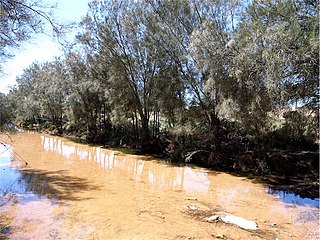
Casuarina obesa, commonly known as swamp she-oak, swamp oak or western swamp oak, or as goolee, kweela, kwerl and quilinock by the Noongar peoples, is a species of flowering plant in the family Casuarinaceae and is endemic to southern continental Australia. It is a dioecious small tree or shrub that forms root suckers, and has drooping or spreading branchlets, the leaves reduced to scales in whorls of 12 to 16, the fruit 10–20 mm (0.39–0.79 in) long containing winged seeds (samaras) 3–5 mm (0.12–0.20 in) long.
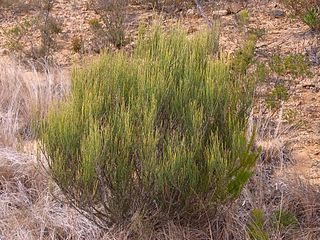
Allocasuarina nana, commonly known as dwarf she-oak or as stunted sheoak, is a species of flowering plant in the family Casuarinaceae and is endemic to south-eastern continental Australia. It is a low, spreading dioecious, rarely monoecious shrub that has branchlets up to 80 mm (3.1 in) long, the leaves reduced to scales in whorls of four to six, the fruiting cones 14–24 mm (0.55–0.94 in) long containing winged seeds 4–6 mm (0.16–0.24 in) long.
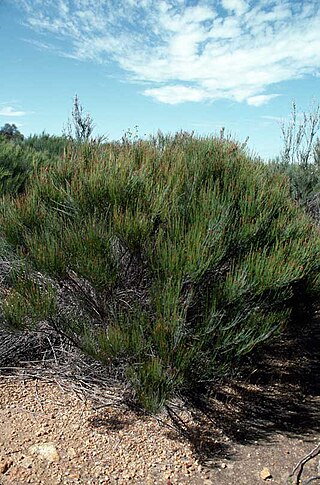
Allocasuarina campestris is a species of flowering plant in the family Casuarinaceae and is endemic to the south-west of Western Australia. It is a dense, monoecious or dioecious shrub that has more or less erect branchlets, the leaves reduced to scales in whorls of seven to nine, the mature fruiting cones 19–42 mm (0.75–1.65 in) long containing winged seeds (samaras) 4.7–10 mm (0.19–0.39 in) long.

Allocasuarina paludosa, commonly known as swamp she-oak or scrub sheoak, is a species of flowering plant in the family Casuarinaceae and is endemic to south-eastern continental Australia. It is a monoecious or dioecious shrub that has branchlets up to 200 mm (7.9 in) long, the leaves reduced to scales in whorls of six to eight, the fruiting cones 10–18 mm (0.39–0.71 in) long containing winged seeds 3.5–5.0 mm (0.14–0.20 in) long.

Allocasuarina paradoxa is a species of flowering plant in the family Casuarinaceae and is endemic to Victoria. It is a dioecious or monoecious shrub that has branchlets up to 150 mm (5.9 in) long, the leaves reduced to scales in whorls of seven to eleven, the fruiting cones 13–25 mm (0.51–0.98 in) long containing winged seeds 4–8 mm (0.16–0.31 in) long.
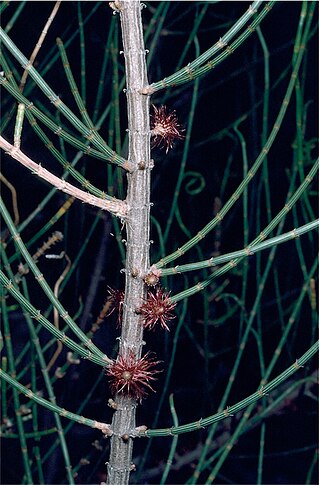
Allocasuarina corniculata is a species of flowering plant in the family Casuarinaceae and is endemic to the south-west of Western Australia. It is an erect to spreading, dioecious shrub that has more or less erect branchlets, the leaves reduced to scales in whorls of six to eleven, the mature fruiting cones 8–15 mm (0.31–0.59 in) long containing winged seeds (samaras) 3–4 mm (0.12–0.16 in) long.

Allocasuarina drummondiana is a species of flowering plant in the family Casuarinaceae and is endemic to the south-west of Western Australia. It is an intricately branched, dioecious shrub that has its leaves reduced to scales in whorls of six or seven, the mature fruiting cones 8–15 mm (0.31–0.59 in) long containing winged seeds (samaras) 3–4 mm (0.12–0.16 in) long.

Allocasuarina eriochlamys is a species of flowering plant in the family Casuarinaceae and is endemic to inland areas of Western Australia. It is a dense, erect, monoecious or dioecious shrub that has more or less erect branchlets, its leaves reduced to scales in whorls of eight to ten, the mature fruiting cones 20–45 mm (0.79–1.77 in) long containing winged seeds (samaras) 5.0–10.5 mm (0.20–0.41 in) long.

Allocasuarina microstachya is a species of flowering plant in the family Casuarinaceae and is endemic to the south-west of Western Australia. It is dioecious shrub that has its leaves reduced to scales in whorls of four, the mature fruiting cones 8–12 mm (0.31–0.47 in) long containing winged seeds 2.5–5.0 mm (0.098–0.197 in) long.

Allocasuarina pinaster, commonly known as compass bush, is a species of flowering plant in the family Casuarinaceae and is endemic to the south-west of Western Australia. It is a prickly, dioecious shrub resembling a pine tree and that has its leaves reduced to scales in whorls of four, the mature fruiting cones 14–25 mm (0.55–0.98 in) long, containing winged seeds 10–11 mm (0.39–0.43 in) long.
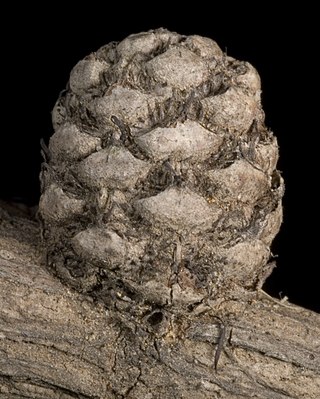
Allocasuarina ramosissima is a species of flowering plant in the family Casuarinaceae and is endemic to the south-west of Western Australia. It is a dioecious shrub with its leaves reduced to overlapping scales in whorls of five, the mature fruiting cones sessile and 9–13 mm (0.35–0.51 in) long, containing winged seeds 4.5–5.0 mm (0.18–0.20 in) long.

Allocasuarina spinosissima is a species of flowering plant in the family Casuarinaceae and is endemic to Western Australia. It is a monoecious shrub with its leaves reduced to overlapping scales in whorls of nine to eleven, the mature fruiting cones 10–23 mm (0.39–0.91 in) long, containing winged seeds 5.5–7.0 mm (0.22–0.28 in) long.
Allocasuarina tessellata is a species of flowering plant in the family Casuarinaceae and is endemic to the south-west of Western Australia. It is a dioecious shrub or tree that has more or less erect branchlets, the leaves reduced to scales in whorls of eight or nine, the mature fruiting cones 26–55 mm (1.0–2.2 in) long containing winged seeds 5.0–7.5 mm (0.20–0.30 in) long.

Allocasuarina muelleriana, commonly known as slaty sheoak, is a species of flowering plant in the family Casuarinaceae and is endemic to southern continental Australia. It is a dioecious, rarely a monoecious shrub that has branchlets up to 120 mm (4.7 in) long, the leaves reduced to scales in whorls of five to eight, the fruiting cones 14–30 mm (0.55–1.18 in) long containing winged seeds 6–9 mm (0.24–0.35 in) long.

Allocasuarina monilifera, commonly known as necklace sheoak, is a species of flowering plant in the family Casuarinaceae and is endemic to Tasmania. It is usually a monoecious, low-growing shrub that has branchlets up to 150 mm (5.9 in) long, the leaves reduced to scales in whorls of six to nine, the fruiting cones 15–30 mm (0.59–1.18 in) long containing winged seeds 5–6 mm (0.20–0.24 in) long.

Allocasuarina pusilla, commonly known as heath oak-bush or dwarf sheoak, is a species of flowering plant in the family Casuarinaceae and is endemic to south-eastern continental Australia. It is a spreading, dioecious shrub with branchlets up to 120 mm (4.7 in) long, the leaves reduced to scales in whorls of five to seven, the fruiting cones 10–15 mm (0.39–0.59 in) long containing winged seeds about 5 mm (0.20 in) long.





















